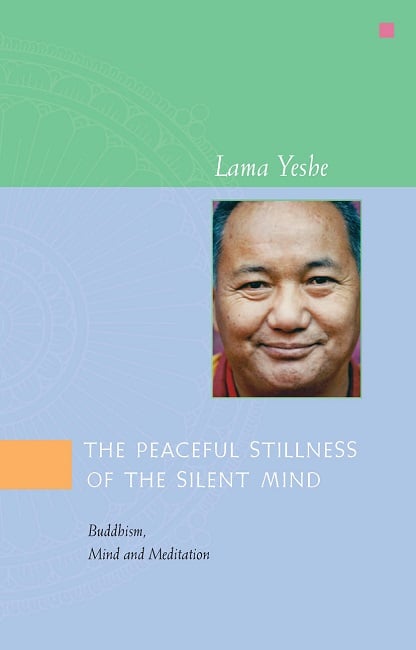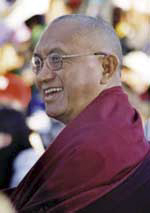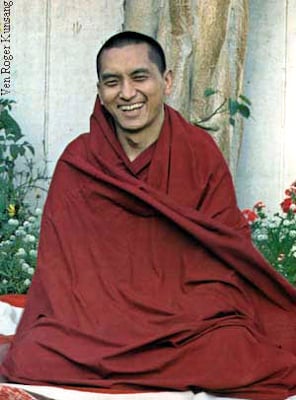Dear Friends,
I hope you are well and happy in the Dharma. I find it hard to remember, but, as Lama Zopa Rinpoche often says, the purpose of our lives, the reason we are human, is to lead all sentient beings from suffering into the bliss of enlightenment. This is our underlying motivation for doing what we do here at the Lama Yeshe Wisdom Archive. Thank you so much for your kind support of and interest in our work.
I was in Singapore and Australia most of February and didn’t have time to prepare a February e-letter, so this is a combined February-March one, containing a slightly longer teaching than usual. On my way back I stopped in California and had a chance to visit one of my teachers, Venerable Ribur Rinpoche. Rinpoche was very happy to receive details of what we’re doing here at the Archive, and spontaneously offered the following advice:
“We are not at the level where we can receive teachings from holy images. There will come a time when we can, but by then we’ll be quite well advanced on the path to enlightenment. Consequently, at the moment we have to rely on books rather than statues for teachings. Therefore, it is more important to publish books than to make statues.
“Also, His Holiness the Dalai Lama often tells Tibetans going back to Tibet that although the Chinese now permit the restoration of monasteries and the construction of statues, it’s more important to print books because books talk to people directly.
“Since Lama Yeshe and Lama Zopa Rinpoche have experienced Dharma in their minds, their teachings are very effective. Furthermore, since their teachings are given in English with knowledge of the psychology of the people they are teaching, they are full of advice suitable for the Western mind.
“There are many Dharma publications in English but these are still a drop in the ocean compared to what is available in Tibetan. Therefore, the job of publishing Dharma in Western languages is even more important.”
I felt very grateful for Rinpoche’s kindness and encouragement.
In California I also spent a little time with Ven. Bob Alcorn, who has begun creating DVDs of our collection of rare archival video of Lama Yeshe. It’s quite a lot of work to enhance the sound and picture quality of these old videos and to subtitle them with a transcript of the teaching being given. The end result is amazing, however, and we hope to start making these DVDs available soon. Watch this space!
 Our new book, Lama Yeshe’s The Peaceful Stillness of the Silent Mind is now available and we’ve started mailing it out to our benefactors, FPMT centers and so forth. Please let us know if you would like a copy. In the meantime, you can see it online.
Our new book, Lama Yeshe’s The Peaceful Stillness of the Silent Mind is now available and we’ve started mailing it out to our benefactors, FPMT centers and so forth. Please let us know if you would like a copy. In the meantime, you can see it online.
Please find another teaching by Lama Zopa Rinpoche below. This one is from the Fifth Kopan Meditation Course, the complete transcript of which can be found on our website.
For more information about our membership program—which helps us edit more teachings for publication and gives you access to a growing number of teachings not available elsewhere—please go here.
And thank you again for your kind support.
Much love,
Nick Ribush
Director
Giving up the eight worldly dharmas
The highly realized pandit and Madhyamaka philosopher Nagarjuna, who restored the sutra and tantra teachings of the Mahayana and caused them to prevail extensively in India when they had degenerated, said, “It’s better not to have the itching than to have the pleasure of scratching.”
In the example, he’s saying that if you don’t itch, you won’t scratch and damage your skin. What he means is that it’s better not to desire worldly objects than to have them.
The point is that if your mind is free of desire, you don’t have any problem with objects, such as the attachment that arises when you contact an object of desire. Conflict arises because there’s desire in your mind. If there’s no desire in your mind, there’s no way for problems to arise when you encounter an object.
Therefore, when I talk about giving up the eight worldly dharmas, I don’t mean you have to make the eight types of object nonexistent. Abandoning the eight worldly dharmas means abandoning the evil thought of the eight worldly dharmas. If you abandon the thought of the eight worldly dharmas, you’ll have no problem with any object: when you experience pleasure, no problem; when the pleasure decreases, again, no problem; when somebody praises you, no attachment to that praise; if you’re surrounded by all kinds of material objects, no problem of craving or conflict in your mind.
Those who abandon the eight worldly dharmas never suffer from attachment. Even if the great yogi Milarepa, for example, was offered every material object in the world, he would never experience the kinds of problem that ordinary people would in that situation. His mind would never change. The minds of beings like Milarepa are always in a state of happiness and peace that cannot be destroyed by external conditions.
When people like us are happy—whether it’s for an hour or a day—it always changes, it never lasts. This is because our happiness arises from the situation, not from mental control. For example, if we meet someone who praises and compliments us, our mind feels uplifted and happy. But later, if that person blames or criticizes us, our mind suffers. This is because we have no mental control; our happiness and suffering derive from the situation we’re in. Our minds’ power is limited, so our happiness never lasts.
The happiness of pure practitioners like Milarepa is completely different. Their happiness arises from mental control, and their fundamental practice is abandoning and controlling the evil thought of the eight worldly dharmas. This is their root, most basic practice. Since their happiness arises from mental control, instead of changing into suffering, their mental peace develops more and more, gets higher and higher. And it all start with their abandoning the evil thought of the eight worldly dharmas; this is their very first practice—the practice that makes them pure practitioners.
As this is what they did, we should do the same. As long as we spend our lives following the evil thought of the eight worldly dharmas, our life is not a pure Dharma life; we are not Dharma practitioners. The definition is made according to practice.
People all over the world are meditating without understanding what real Dharma actually is. So even though they do all that meditation, their lives are wasted. Why is it not Dharma even though they spend most of their time in meditation? It’s because they don’t have a real understanding of the nature of suffering, of what suffering and its cause actually are; they don’t know the difference between positive and negative actions. Their minds are not aware of these subjects, which are actually the most important things for those seeking ultimate peace to discover. They think that simply meditating, just sitting in some position, is a good action, that it brings peace, but in fact it’s the opposite.
Why do people who meditate without the wisdom understanding these important subjects waste their time and life? It’s because most of their daily life—even the meditation they do, which they think is the cause of ultimate peace—is servant to the eight worldly dharmas.
When moths see a candle flame, they think it’s a good place to go. They don’t think that it will burn their body; they have no fear. If they were afraid, they wouldn’t so purposefully fly right into it. The more you try to stop them, the harder they try to enter the flame. This shows the nature of the animal mind. Anyway, when those moths fly into the flame they’re expecting only peace and happiness. They have no desire to suffer; they don’t plan on getting burnt. So why do they go there? It’s because they have no fear. Their lack of fear is due to their lack of understanding that if they go there they will suffer. What happens is the complete opposite to what those ignorant creatures think will happen—they get burnt; they die.
It’s very important to understand why they force themselves to experience this suffering, what makes them do it. This is the real science; this is the best way of studying science.
Why do the moths intentionally fly into the flame? Why do they try their hardest to get into it as quickly as possible? It’s because of their own ignorance—the mental obscuration that prevents them from discovering the actual nature of the situation: that the fire is hot and will burn them. Their ignorance makes them perceive the situation differently from the fact of it. Some people might think that moths are happy to be in there, but they’re not. If they knew what was going to happen they would avoid it at all costs.
Kopan Monastery, 22 November 1973. Edited from the Lama Yeshe Wisdom Archive by Nicholas Ribush. A transcript of the entire course is available on our website.

































